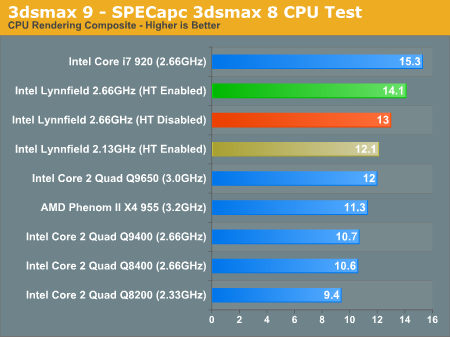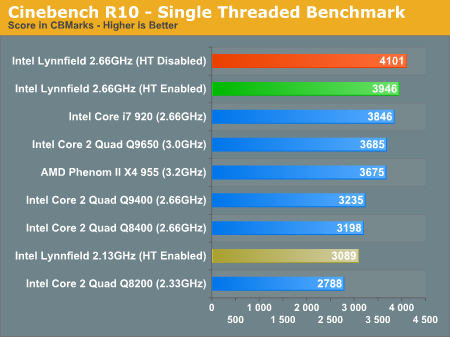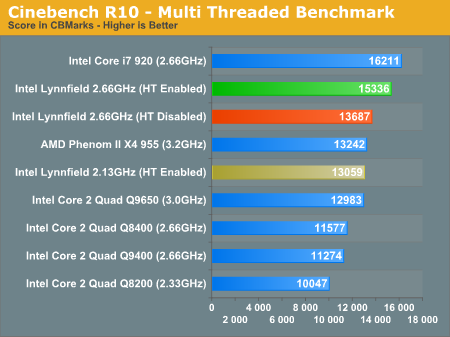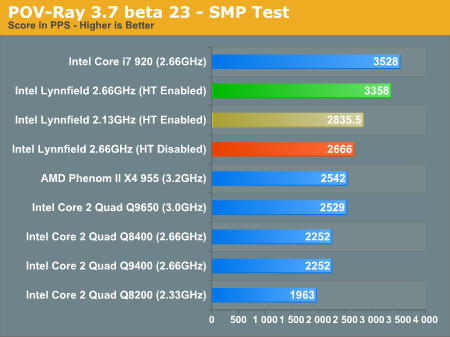The Lynnfield Preview: Rumblings of Revenge
by Anand Lal Shimpi on May 29, 2009 1:00 PM EST- Posted in
- CPUs
3dsmax 9 - SPECapc 3dsmax CPU Rendering Test
Today's desktop processors are more than fast enough to do professional level 3D rendering at home. To look at performance under 3dsmax we ran the SPECapc 3dsmax 8 benchmark (only the CPU rendering tests) under 3dsmax 9 SP1. The results reported are the rendering composite scores:

There are three key takeaway points here.
1) Hyper Threading allows the i7-920 to outperform the entry level Lynnfield by nearly 18%.
2) With HT disabled, the $196 Lynnfield is faster than the $316 Core 2 Quad Q9650. It's a true replacement for Penryn in the lineup.
3) Intel could release an even slower Lynnfield and, by enabling HT, offer a chip faster than all other Penryn and Phenom II based processors in the market.
Cinebench R10
Created by the Cinema 4D folks we have Cinebench, a popular 3D rendering benchmark that gives us both single and multi-threaded 3D rendering results.

The single threaded Cinebench test shows us just how powerful the Nehalem core is. Remember, we're looking at single-core performance here.
Without an aggressive turbo mode, the 2.66GHz Lynnfield sample is faster than a 3.0GHz Penryn. Even at 2.13GHz Lynnfield is able to perform like a 2.5GHz Penryn. This is a very flexible core.
These results also give you an indication of exactly how strong the dual-core Nehalem derivatives will be in notebooks late this year and into 2010.

Crank up the thread count and feel the frustration brew. The entry level Lynnfield won't have Hyper Threading enabled, and thus it'll only outperform the Phenom II 955 by 3.4%. Had Intel enabled the HT switch, Lynnfield would not only be 16% faster than AMD's best but it would also be only 5% slower than the i7-920.
POV-Ray 3.73 beta 23 Ray Tracing Performance
POV-Ray is a popular, open-source raytracing application that also doubles as a great tool to measure CPU floating point performance.
I ran the SMP benchmark in beta 23 of POV-Ray 3.73. The numbers reported are the final score in pixels per second.

We see a similar story in POV-Ray.










95 Comments
View All Comments
TA152H - Saturday, May 30, 2009 - link
Actually, Jarrod, your logic is flawed.AMD does that triple core and dual core so they can salvage processors that would be thrown out. Also, dual core can be faster than quad, since you can generally clock higher, since you have less heat and your limit is only the slowest of two cores, not four. But, in any event, there are a lot of instances where going to four cores is not going to help much. The Lynnfield is slower in a lot more things.
You're also confused about dual-channel and tri-channel. I never said dual-channel was bad, I said Lynnfield was. The i7 with dual channel performs better than the Lynnfield, so don't get the two confused.
The difference in performance between the i7 and Lynnfield is dramatic considering they are the same except for the memory controller. Anyone here who buys a Lynnfield is probably making a mistake, since it's easy to overclock the i7, and you can't fix the brain-damaged Lynnfield.
What your saying is what I have been. Stick with the i7 and let it go down in price, instead of crippling it and selling that as the lower cost part. Where I disagree with you is, I don't think the i7 platform is going to be much less expensive to make. Maybe you have the sizes for all the parts, but I don't think you'll see a significant difference in the costs. A lower end chipset without so many PCIe lanes for the i7 could have brought the system costs a lot closer, and you wouldn't have to castrate the processor.
Also, because now you have more functions on the processor, it's very possible it will not clock as high. It will, after all, generate more heat, presumably, since it's got more on it.
I don't think Intel made a good compromise with this. To lose so much performance with just a memory controller change is shocking to me. Maybe it's new silicon, and maybe that's most of the performance loss, but it doesn't make sense to me. It's not the same as a smaller L2 cache that makes the processor a lot smaller. Or salvaging processors that would otherwise be thrown out, where there is a very meaningful cost difference. This seems more like a market segment type of thing.
JarredWalton - Saturday, May 30, 2009 - link
I think you're putting WAY too much emphasis on these early benchmarks. I expect final Lynnfield to perform faster than the i7-920 in most cases (outside of heavily threaded workloads like 3D rendering). There are tons of people that:A) Never do 3D rendering
B) Never do video encoding/transcoding
C) Never overclock
For those users, the enhanced Turbo on Lynnfield combined with lower costs makes perfect sense. We are after all looking at a platform cost that will be about $150 less than Core i7 + mobo, plus you buy RAM in pairs instead of triplets.
We'll have to see how Lynnfield clocks with final CPUs before making any judgments; I certainly don't think the sample Anand has is representative of final chips in performance, clocking, or various other areas. As he mentions, the motherboard BIOS releases still look like they're not ready for the public, and that can make up for the "huge" 5% performance gap.
For people looking at faster dual-core chips for gaming (i.e. Core 2 Duo E8500/E8600), I suspect that the Lynnfield will outperform them across the board, with or without overclocking. They'll be about the same price too, all told.
GeorgeH - Friday, May 29, 2009 - link
When the "real" test comes out, I'd be very curious to hear your thoughts on the USB, SATA, and PCIe 3.0 standards, as all three have been rumored to be out in late 2009 or early 2010. With PCIe 2.0 integrated onto the CPU and USB/SATA 2.0 being locked in on the motherboard (ignoring add-on cards) it seems as if first gen systems could end up being a major loser in terms of longevity and upgradeability.jmke - Friday, May 29, 2009 - link
When I got to the last page and started reading the Why would anyone want a LGA-1366 system then? , I got a nasty flashback. S939 vs S754: we all knew S754 was a dead end, right from the start; why o why is Intel taking this same decisions? Build one platform, let it scale all the way up and down; why force people to upgrade motherboard to upgrade their CPU :-/philosofool - Saturday, May 30, 2009 - link
Because you and I, the DIY system builders, represent about 0.3% of the market for computers. Socket decisions are driven entirely by the needs of Intel, Dell, HP and the rest of the network of manufactures. Those people want an inexpensive successor to LGA 775, which 1366 was not. I'm not sure why intel wanted a performance socket, but I don't think 1366 is leaving the scene. It will just be part of the "high end" market. LGA 1156 will include mainstream parts eventually. However, looking at the cost of Core i5, I have to say that I'm probably not canceling my plan to upgrade to a Phenom X3 720.Depeche - Friday, May 29, 2009 - link
If it wasn't for AMD Intel would just price their processors whatever they want it to be. AMD is out there so that Intel drops their prices :)lopri - Friday, May 29, 2009 - link
is what Intel wants, obviously. And it is succeeding. More sockets, more patents, more incompatibility... and We're going back to $200, $500, $1,000 tiers in CPU prices. I'm surprised that you have no complaint, Anand. Well, actually you think the opposite! (Page 2: Making Nehalem Affordable??) Wow!Umm..? I thought PCH was just a new name for ICH. Is there any other functionality in PCH that does not exist in ICH?
Apparently Intel saw the danger of 3rd party PCBs for Lynfield CPUs, and that is why these CPUs are priced so high despite being designated as "Mainstream". (Though I am certain Intel will do anything it can to prevent 3rd party to develop motherboards for these CPUs - at least until DOJ threatens it with anti-trust investigations)
Forgetting all the dirty business stuff, Lynfield is no doubt an admirable piece of silicon. It is a fine engineering that no one else has achieved yet. I'm anxious to get my hands on it when it's out. I have an i7 920 sitting in a box for nearly two weeks now because I can't seem to find a board that suits my needs/wants. I hope we'll see variety of creative motherboards for Lynfield CPUs now that these CPUs aren't (presumably) shackled to QPI BS.
Anand Lal Shimpi - Friday, May 29, 2009 - link
Note that these are performance desktop parts. They are mainstream for quad-core CPUs but not designed for the sub-$500 system market. You will see 32nm Westmere derivatives in the $100 - $200 range and eventually even lower.Third party motherboard makers already have P55 boards in development for Lynnfield, the majority of P55 boards for Lynnfield won't be made by Intel.
Take care,
Anand
Kary - Friday, May 29, 2009 - link
I think this was more a reference to third party CHIPSETSLike Nvidia's ION upset Intel
Different manufactures using the same chipset don't really make that different of boards (compared to completely different chipsets made into boards by different manufacturers)
Anand Lal Shimpi - Friday, May 29, 2009 - link
The chipset honestly doesn't do much these days. It acts as a PCIe switch and delivers basic standards: USB, SATA, GigE, etc... Long term I think we'll see that AMD makes AMD chipsets and Intel makes Intel chipsets, I don't see much room for someone like NVIDIA there.Where NV does add value is in graphics, and there's nothing preventing NVIDIA from continuing to deliver graphics to both Intel and AMD platforms. I don't believe we'll see much of a future in 3rd party integrated graphics chipsets on either AMD or Intel platforms, both manufacturers will be bringing graphics on-package.
At this point I view NVIDIA's platform strengths as being predominantly in mobile applications (think MIDs, smartphones, notebooks) and unfulfilled niches like Atom + Ion. On the graphics side, NVIDIA is quite strong, it's just the platform strength that has eroded over time.
Take care,
Anand